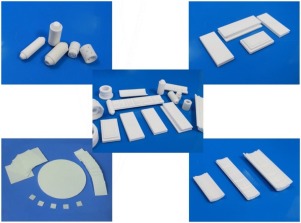当前位置:
X-MOL 学术
›
J. Ind. Eng. Chem.
›
论文详情
Our official English website, www.x-mol.net, welcomes your
feedback! (Note: you will need to create a separate account there.)
Advanced Ceramic Components: Materials, Fabrication, And Applications
Journal of Industrial and Engineering Chemistry ( IF 5.9 ) Pub Date : 2020-05-01 , DOI: 10.1016/j.jiec.2020.02.002 Tunmise Ayode Otitoju , Patrick Ugochukwu Okoye , Guanting Chen , Yang Li , Martin Onyeka Okoye , Sanxi Li
Journal of Industrial and Engineering Chemistry ( IF 5.9 ) Pub Date : 2020-05-01 , DOI: 10.1016/j.jiec.2020.02.002 Tunmise Ayode Otitoju , Patrick Ugochukwu Okoye , Guanting Chen , Yang Li , Martin Onyeka Okoye , Sanxi Li

|
Abstract The global demand for ceramic materials with wide-ranging applications in the environment, precision tools, biomedical, and electronics, and environmental fields is on the increase. Several ceramic materials and methods of fabrication have been developed with task-specific properties. The material, the fabrication methods, and processing conditions impel characteristics including corrosion-resistant, outstanding optical and electrical properties, hardness and anti-aging. In this review, various materials for the preparation of ceramics and ceramic composites components were investigated to demonstrate the contribution of the materials and different fabrication methods to the properties of the ceramics components. The material properties, sintering temperature, casting technique, and pressure influences the ceramics grain size and porosity, which have an explicit effect on mechanical strength, corrosion-resistant, and optical properties of the ceramic components. The finishing of the ceramic components into a machinable shape requires careful attention to avoid defects. However, most conventional finishing methods are cost-intensive, hence, the need to commercialize 3-D printing for large scale and long-run applications. It is hoped that this review would propagate wider research on low cost and energy effective pathways to produce ceramics with dynamic properties, which can be applied in several fields with outstanding performance.
中文翻译:

高级陶瓷组件:材料、制造和应用
摘要 全球对陶瓷材料在环境、精密工具、生物医学和电子以及环境领域的广泛应用需求不断增加。已经开发了几种具有特定任务特性的陶瓷材料和制造方法。材料、制造方法和加工条件具有耐腐蚀、出色的光学和电气性能、硬度和抗老化等特性。在这篇综述中,研究了用于制备陶瓷和陶瓷复合材料部件的各种材料,以证明材料和不同制造方法对陶瓷部件性能的贡献。材料特性、烧结温度、铸造工艺和压力会影响陶瓷的晶粒尺寸和孔隙率,它们对陶瓷部件的机械强度、耐腐蚀性和光学性能有显着影响。将陶瓷部件精加工成可加工形状需要仔细注意以避免缺陷。然而,大多数传统的精加工方法都是成本密集型的,因此需要将 3D 打印商业化以用于大规模和长期应用。希望这篇综述能够促进对低成本和节能途径的更广泛研究,以生产具有动态性能的陶瓷,该陶瓷可应用于多个具有出色性能的领域。大多数传统的精加工方法都是成本密集型的,因此需要将 3D 打印商业化以用于大规模和长期应用。希望这篇综述能够促进对低成本和节能途径的更广泛研究,以生产具有动态性能的陶瓷,该陶瓷可应用于多个具有出色性能的领域。大多数传统的精加工方法都是成本密集型的,因此需要将 3D 打印商业化以用于大规模和长期应用。希望这篇综述能够促进对低成本和节能途径的更广泛研究,以生产具有动态性能的陶瓷,该陶瓷可应用于多个具有出色性能的领域。
更新日期:2020-05-01
中文翻译:

高级陶瓷组件:材料、制造和应用
摘要 全球对陶瓷材料在环境、精密工具、生物医学和电子以及环境领域的广泛应用需求不断增加。已经开发了几种具有特定任务特性的陶瓷材料和制造方法。材料、制造方法和加工条件具有耐腐蚀、出色的光学和电气性能、硬度和抗老化等特性。在这篇综述中,研究了用于制备陶瓷和陶瓷复合材料部件的各种材料,以证明材料和不同制造方法对陶瓷部件性能的贡献。材料特性、烧结温度、铸造工艺和压力会影响陶瓷的晶粒尺寸和孔隙率,它们对陶瓷部件的机械强度、耐腐蚀性和光学性能有显着影响。将陶瓷部件精加工成可加工形状需要仔细注意以避免缺陷。然而,大多数传统的精加工方法都是成本密集型的,因此需要将 3D 打印商业化以用于大规模和长期应用。希望这篇综述能够促进对低成本和节能途径的更广泛研究,以生产具有动态性能的陶瓷,该陶瓷可应用于多个具有出色性能的领域。大多数传统的精加工方法都是成本密集型的,因此需要将 3D 打印商业化以用于大规模和长期应用。希望这篇综述能够促进对低成本和节能途径的更广泛研究,以生产具有动态性能的陶瓷,该陶瓷可应用于多个具有出色性能的领域。大多数传统的精加工方法都是成本密集型的,因此需要将 3D 打印商业化以用于大规模和长期应用。希望这篇综述能够促进对低成本和节能途径的更广泛研究,以生产具有动态性能的陶瓷,该陶瓷可应用于多个具有出色性能的领域。











































 京公网安备 11010802027423号
京公网安备 11010802027423号